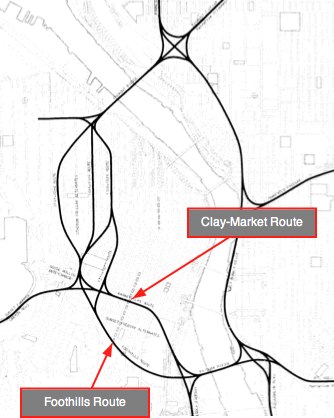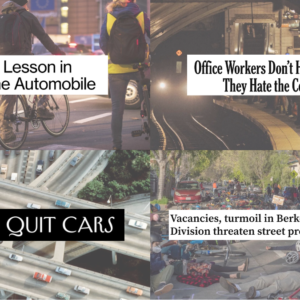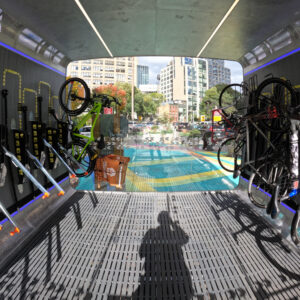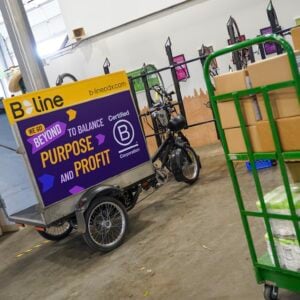“We should avoid putting all of our eggs in the freeway basket. In the long run, the most efficient mass transportation is by means other than private automobile… catering to the whims of the individual in his own automobile has proven to be an outrageously expensive luxury…”
— City Club of Portland, 1960
50 years ago this week, The City Club of Portland published a report that provides a window into the mood of our city toward transportation at the height of the automobile age.
The Report on Freeways Location was published by a five-member City Club committee on June 24th, 1960. The document was drafted in order to provide the State Highway Commission and city planners guidance to decide the best route for a future freeway that would pass through downtown.
1960 was just four years after the U.S. Congress passed the National Interstate and Defense Highways Act. Using gas tax revenue, the federal government offered to pay 90% of the tab for highway construction.
In their report, the City Club committee analyzes several possible locations of a new freeway route through downtown (see map graphic at right) that would connect freeways on the west side to the future Marquam Bridge and the already-built Banfield/I-84 on the east side. The two options under discussion were the “Clay-Market Route” and the “Foothills Route.”

(Source: City Club of Portland, 1960)
What struck me in reading this report is the obvious skepticism about freeways from the researchers and their clear understanding of how new freeway construction would impact surrounding land use. Even with the feds happily handing over 90% of the tab, the City Club was far from sold on the idea of rushing into freeway construction and they were candid with their feelings about car use in general.
“The automobile is creating a monstrous problem that Portlanders are only beginning to appreciate. It tends to transform people into impersonal machine operators who lose identity and who lose appreciation of the existence of a human in the other vehicle. This undesirable effect of the psychology of the individual is only slightly overshadowed by the problem created by the attempt of vast numbers of these machines to get to the same place at the same time.”
In the “Discussion” section of the report, the researchers note that to truly solve the “problem of getting people moved from one place to another” there should be plans for “comprehensive public transportation as well as for the private auto”:
“We should avoid putting all of our eggs in the freeway basket. In the long run, the most efficient mass transportation is by means other than private automobile… Cities have found that catering to the whims of the individual in his own automobile has proven to be an outrageously expensive luxury which the cities cannot possible continue to satisfy fully.”
The committee made it clear they felt the decision on the new freeway — set to be made just weeks after this report was published — was being rushed. They wanted to wait until a comprehensive traffic study could be completed before any decisions were made (one was in the works, but wouldn’t be done for 18 months). Begrudgingly, the committee recommended the Clay-Market Route because they felt it would integrate more easily with city traffic (bringing people closer to their destinations than the Foothills Route), transit, and parking needs. They were also concerned that the Foothills Route would cut off some parcels of land from the downtown core.
In the end, the Foothills Route was selected. It was noted in the report that the Foothills Route would be less expensive to build, would not become congested as quickly, and would be easier to build.
Last week I went on the Dead Freeways Ride led by local urban historian Shawn Granton. We stood on a small patch of grass outside some apartments just south of Portland State University and I-405 (the Foothills Route section). Granton told us how the freeway had cut off this and several other residential areas from the rest of the city. It seems some of the City Club’s concerns were warranted.
Today, the Project Sponsors Council of the Columbia River Crossing project is meeting in downtown Portland. Hopefully they and other planners and decision makers will use the same caution in building highway projects as this five-member City Club committee did 50 years ago.
— You can download a PDF of the Report on Freeways Location here. For more on Portland’s freeway history, read The Dead Freeway Society published in the Portland Mercury back in September.








Thanks for reading.
BikePortland has served this community with independent community journalism since 2005. We rely on subscriptions from readers like you to survive. Your financial support is vital in keeping this valuable resource alive and well.
Please subscribe today to strengthen and expand our work.
Wow. Thanks for that little peak into history, Jonathan. I like the language.
that’s an awesome quote you put there in the sidebar… those were some very forward-looking people who really looked at the big picture and the effect on the greater good of the city… we can only dream of city workers who are that in-tune…
Wow, as impressive as those quotes are, the implication is discouraging: despite a clear understanding of the “monstrous problem” by articulate leaders 50 years ago, the roots of the problem are still strong and deep. Portland–then and now–may be a bright spot in the nation, but even its non-automotive record is only encouraging in comparison to other American cities.
I’m am impressed by the foresight and insight people writing this report had. I’m a bit disheartened by the rhetoric of today that pushes jobs, commerce and individualistic wants over the needs of neighborhoods, livability and of people (instead of persons).
i’m 44. as a small child i lived in outer sprawlburbia, southern california. i vividly remember reading, as soon as i could read, about how portland was pushing back on freeways and putting in light rail. i never forgot that, and over 30 years later we moved here to raise our boy in a bike-friendly place. portland seems never to have entirely forgotten the patterns it was developed upon, before cars turned its quiet streets into parking lots and its busy ones into no place for the slow.
Thankfully we have the freeways we did get. Can you imagine all those cars jammin through the neighborhood streets
jim #6
Right. Have you heard about induced demand? http://en.wikipedia.org/wiki/Induced_demand The point is we wouldn’t have ‘all those cars’ we have today without those freeways. While Portland can’t act alone–the Interstates would have been built even if Portland had objected–but widening roads, building freeways is implicated in the growth of automobility.
That is precisely why in some places they’ve torn up freeways. We used to just widen the road or freeway, but as we all know that doesn’t really ‘solve’ the problem, it just makes driving less of a hassle so more folks get in their car more often.
A bit more on induced traffic:
“When a roadway improvement encourages development on the outskirts of an urban area, the development pattern tends to be automobile-oriented. Thus, over the long-term, the portion of generated traffic made up by induced traffic tends to increase significantly, and the costs to society of this type of development are far higher, particularly in an era of concern over excessive use of fossil fuels. Such costs are rarely if ever considered when new roadway capacity is being planned.”
found here: http://streetswiki.wikispaces.com/Induced+Traffic
It’s amazing that at the time when the “What’s good for GM is good for America” ethos reigned supreme, a few locations could see the folly of bending to every automotive whim, and could see the problems of automotive travel for social interaction.
For anyone who is interested in this topic, I highly recommend checking out the book (technically a thesis, but it’s a page-turner) called “In the Shadow of a Concrete Forest” by Val Ballestrem which is at the PSU library.
The book covers in depth the history of the Mt. Hood Freeway and the events that stopped its construction.
“Cities have found that catering to the whims of the individual in his own automobile has proven to be an outrageously expensive luxury…”
And when you express this sentiment today you get called a radical. Are we really making any progress? At least the Max is a shining example of what mass transit can do, even if TriMet is stuck in the stone ages with its troglydite bus drivers.
jim (#6) – Yes, I can – I can imagine a city in which the top speed is 35mph, where car travel is inconvenient enough that most trips are made by transit or by bicycle or on foot. I can imagine reclaiming dozens of parking garages and hundreds of parking spaces that are no longer needed due to fewer cars and transforming them into parks, plazas, gardens, and tiny houses for those who’d like to live in a smaller footprint. I can imagine less exhaust, greater community, street fairs, jobs near where people live, multi-use spaces, and lots of good times.
Thanks so much for prompting that thought exercise!
The funny part is that Hayden Island should be fighting CRC tooth and nail, because otherwise they’re going to get the biggst freeway nightmare the region has ever seen, and there will be this gigantic area of the island perpetually in shadow and frequented by no one.
9 watts (#8) – In 1989, Metro Detroit opened the final stretch of I-696. Within 12 months that road had exceeded its designed capacity.
Oh, and jim, the traffic on 10 mile, 11 mile, and 12 mile, the parallel surface streets, INCREASED during the same period, after a brief initial decrease. This was during a period when the city’s population was falling and the metro area population was steady or slightly declining.
As a bike commuter, I find that biking makes me a more slow and careful driver, willing to tolerate 35 mph in a car. Maybe that’s just periodically catching up to drivers who’ve floored it only to stop at the next light, or maybe it’s enjoying the travel aspect of travel, instead of just the “getting there” part of it.
As a bike commuter, I find that biking makes me a more slow and careful driver, willing to tolerate 35 mph in a car. (#14)
I’ve noticed this too. I think it is also because my travel time expectations have been reset. When I drove everywhere, I felt like I should be somehere instantly and any delay was unacceptable. As a cyclist, I have a better tolerance for how long it takes to get somewhere and I no longer expect to be there NOW.
I agree with 9 watts that “…the Interstates would have been built even if Portland had objected …”. There’s got to be a way for through motor vehicle traffic from outside the city to bypass it if some semblance of livability is to be preserved. The solution to various problems that highways were thought to be, got out of control, winding up with the solution itself becoming a problem.
For years already, there’s been a push to build a west side bypass, idea being to alleviate, redistribute…whatever… congestion on Hwy 217. No thanks. That would be just another expensive mess, creating more sprawl.
So far, the west side bypass has always been voted down, but some of the forces behind that kind of project are still here, so we see the urban growth boundary progressively pushed further out while insufficient effort is made to more constructively use already zoned and/or developed land within the boundary.
Improvements to the land within the boundary could be made, as picio says in comment/reponse to jim, “… parks, plazas, gardens, and tiny houses for those who’d like to live in a smaller footprint. I can imagine less exhaust, greater community, street fairs, jobs near where people live, multi-use spaces, and lots of good times. …”, but it happening depends upon the public’s recognition of the need for that kind of living environment growing, and the public demanding that the land be developed to provide it.
we dont need to have all of the housing cramed into downtown, we need housing near where the jobs are. how many of you actually work downtown? When our population doubles we aren’t all going to be all stacked up in tiny condo’s. even if you do live within bike distance of your job, stores, bars… you are still going to need an increased infrastructure to survive. If you dont keep up traffic will be sitting in a jam making smog. thats the fact, put down the pipe and quit fantasizing about a utopia without cars- its all fantasy
“quit fantasizing about a utopia without cars- its all fantasy”
jim, I don’t see anything wrong with talking about a utopia. Perhaps you should look up the word before you hit people over the head with it. What I think is wrong is putting people down for doing so. And for what it’s worth, I will put money down that the fantasy that lacks a basis in reality is the idea that cars are here to stay. In ten years, we’re going to be sorry we built all those superhighways.
…and how is it that “you are still going to need an increased infrastructure to survive”? Can you explain? I don’t think up until now anyone was talking about survival. Freeways weren’t built and widened to help people survive, but to help folks with cars and trucks get places much much faster–but at considerable cost to those who happened to live where the highways got built (and that is just counting the immediate impacts).
I meant to say
‘in ten years even *you* will be sorry we built all those highways. I’m already sorry.’
Would you rather have those thousands of cars going down your street instead of a freeway?
except portland (among many cities) shows that you can have pedestrian, bicycle and transit oriented communities that arent very dense… just look to the eastside, its almost entirely single family detacted houses.
“… we dont need to have all of the housing cramed into downtown, we need housing near where the jobs are …” jim #17
So let’s not allow the jobs to lead development further and further out onto open land. Bring the jobs in, or let employment currently located in outlying areas ascend above the footprint of buildings where it already exists, if more room is needed. If leaders on all levels of the political and professional spectrum are determined to support increased population growth, let us at least keep this growth from methodically obliterating the natural environment that is so essential to community livability.
Read the Oregonian story via this link. It tells of the latest assault on open land and contribution to sprawl out in Bethany. The saving grace so far, is that bureaucrats and developers are having a hard time coming up with the money to build the roads to service this development.
Sounds like they may not build until they do. Build new roads, while taxpayers are already strapped to maintain current road infrastructure. Right now, the area described in the article is green fields. That’s where many of us ride when we need to get away from the city for awhile.
North Bethany’s future relies on corralling transportation money and raising new taxes and fees/Oregonian/Brad Schmidt
wsbob=
Portlands leaders are forcing bussiness’s out of portland into the suburbs. If you don’t want that then you need to start with new city leaders that are bussiness freindly
“wsbob=
Portlands leaders are forcing bussiness’s out of portland into the suburbs. If you don’t want that then you need to start with new city leaders that are bussiness freindly jim #23
jim…you don’t offer reasons why you think city leaders aren’t business friendly. One of the reasons Washington County was able to be ‘friendly’ to business in a way that Multnomah County couldn’t as easily, is that Wash Co had a lot of open, undeveloped land that it was willing and able to offer to business, that Mult Co was not able to, at very attractive prices.
For Wash Co, that was a good, short term strategy. Long term for the region, it means ever increasing pressure on Hwy 26 and other roads to move people back and forth between home, jobs and shops. That’s a problem that has gotten to be very expensive and cumbersome to fix.
I hear it frequently said that it costs more to build up than out. True as that may be, communities designed so that great numbers of people can walk and bike back and forth between home, jobs and shops would likely save lots of expenditures on infrastructure required for expanded roadways and their maintenance. Those savings from this type of design, that could potentially offset comparatively higher costs of setting up and doing business in the already built environment.
On a fundamental level, the rationale for relentlessly covering over the green fields of Washington County and other open lands is hardly any more right than the one unsuccessfully used decades ago, to try defend gouging a freeway east through the quiet neighborhoods of South East Portland and beyond.
re: “Would you rather have those thousands of cars going down your street instead of a freeway?” (jim, #20). I don’t think you’re understanding the concept of induced demand. Many of those thousands of cars are only there BECAUSE we built the freeways.
One way to fight the effect of freeways would be to forcibly reduce their speeds, thus reducing the incentive towards sprawl. How about limiting their speeds? Of course we still need higher rural speeds to get from town to town, but how about a state law limiting roadway speeds WITHIN URBAN GROWTH BOUNDARIES to 45mph on limited access roads (i.e., freeways — turning them into parkways), and 35mph on all other streets? No more racing from stoplight to stoplight on 45mph suburban arterials, and you wouldn’t feel like you can just blast between Beaverton and Portland at a mile per minute. This would only increase the actual (legal) driving time between PDX and Beave by two minutes, but the psychological effect would be profound. Not to mention the fuel savings.
Vancouver, BC saw what happened in Seattle, LA and elsewhere and managed to prevent freeways from blasting through the city, destroying communities, depriving people of transportation choices, and otherwise making the city less livable. Result: a booming, thriving metropolis with wonderful inner cities neighborhoods, and so desirable that housing prices are among the highest in North America. Somehow fending off highways not only didn’t cost jobs; it made Vancouver even more economically attractive and more livable.
Assuming that all the cars now on the highway would suddenly hit the streets is misguided. Good planning provides green alternatives to single occupancy cars — buses, rail, bikes, and neighborhoods near jobs.
But I guess we should stop fantasizing about utopias. I remember when a few people fantasized about a country where black and white people could attend the same schools, vote, drink from the same water fountains…. stupid dreamers.